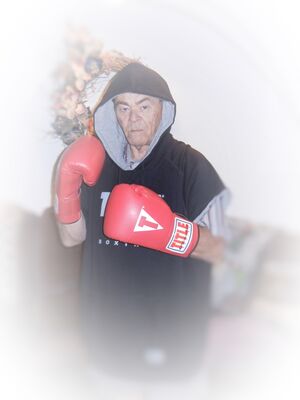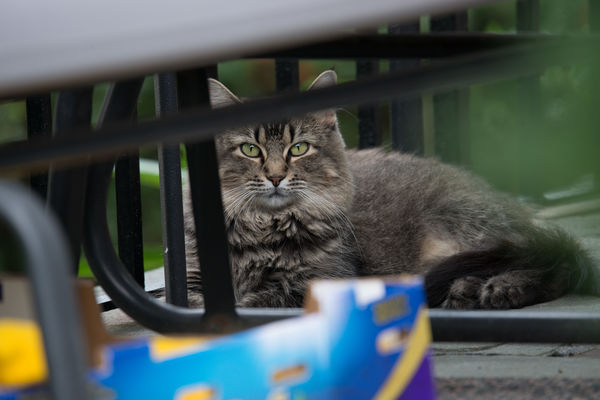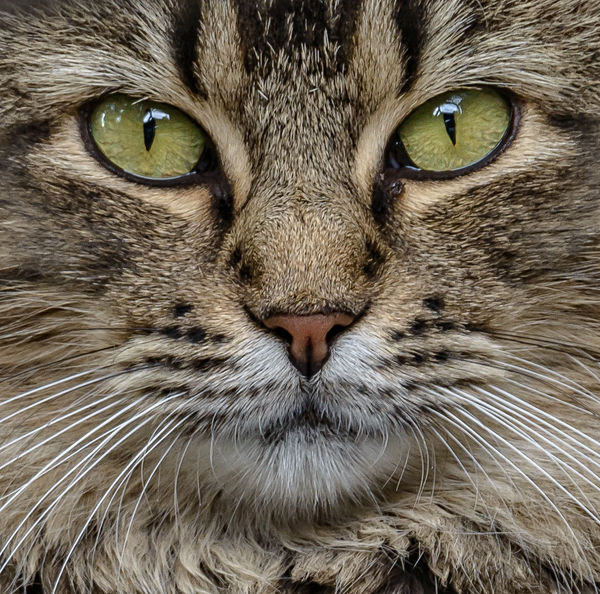Motion Blur
Jun 17, 2018 03:20:14 #
Sunnely wrote:
A (newbie) inquiring mind wants to know. Does this rule apply for all types of digital camera such as full-frame, DSLRs, 4/3? Thanks.
You need to modify the values depending on the crop factor. For example, for a focal length of 100mm, a full frame (FF) camera would need a shutter speed of (at least) 1/100, for an APS-C (DX) camera it would be 1/150, and for 4/3 cameras it would be 1/200. For the higher values of zoom you would be looking to speed it up even more than the rule of thumb suggests.
Remember that these are all for hand-held shots. With a tripod you still need to worry about movement within the frame (which may include things like wind-blown vegetation, people/children/animals moving about etc). A wireless remote or cable release will remove the possibility shutter release induced camera shake. With a monopod you can't forget camera movement completely, but you'll get away with far lower shutter speeds, and it's still worth trying to improve your shutter release technique (very similar to shooting rifles).
Jun 17, 2018 05:57:59 #
catchlight..
Loc: Wisconsin USA- Halden Norway
Not true, That is the general rule to prevent camera shake... things change with stabilization control.
https://www.photographymad.com/pages/view/shutter-speed-a-beginners-guide
https://www.photographymad.com/pages/view/shutter-speed-a-beginners-guide
Traveller_Jeff wrote:
The standard rule for minimum shutter speed to avoid motion blur is to match the speed to the focal length.
50mm: 1/50th of a second. 300mm: 1/300th of a second. ISO is an irrelevant parameter.
50mm: 1/50th of a second. 300mm: 1/300th of a second. ISO is an irrelevant parameter.
Jun 17, 2018 11:07:15 #
Sunnely
Loc: Wisconsin
wdross wrote:
Yes, it does but with some modification for sensor size. The angular view with a 4/3rds 300mm is the same as that of a FF 600mm. Therefore, without image stabilization, one must compensate for the angular view for the format being used.
Thanks for your response for 4/3 cameras and full frame focal length. It looks like it's multiplied by 2 re: full frame equivalent.
What about DSLRs? I'm still unclear regarding this issue. Could you address the issue of DSLRs and full frame re: focal length and shutter speed? Do you convert the DSLR crop factor to its full frame equivalent of 35 mm to set the shutter speed for hand-held shooting or not? I believe the DSLR crop factor is x 1.5. For example, for a DSLR with focal length of 200 mm, would you set the shutter speed to no slower than 1/200 (no crop factor) or no slower than 1/300 (200 x 1.5 crop factor) for hand-held shooting? In short, re: focal length and shutter speed for DSLRs, do you or not factor in the crop factor?
Thanks.
Jun 17, 2018 12:57:01 #
wdross
Loc: Castle Rock, Colorado
Sunnely wrote:
Thanks for your response for 4/3 cameras and full ... (show quote)
Try using the term "cropped sensor" or APS-C instead of DSLR. DSLR stand for "digital single lens reflex" which can be used for any format. Sometimes people lump in the digital mirrorless in with them too because of the interchangeable lenses even though there is no reflex mirror.
You have grasped the concept that both R.G. and I have stated. Yes, for a crop sensor you have to increase the shutter over what you would do for a FF lense by 1.5X. The smaller the sensor, a higher speed will be required.
Jun 17, 2018 13:12:18 #
gvarner wrote:
If you are using a flash, then it should kill any motion blur, either camera jiggle or subject motion. You may have a focus issue.
Flash if balanced to or less than the existing light values it will not kill motion blur. The edges of the subject can appear to be two images laid on top of each other which will look like motion blur until enlarged. Out of sync flash will be similar.
Jun 17, 2018 15:45:25 #
Sunnely
Loc: Wisconsin
wdross wrote:
Try using the term "cropped sensor" or A... (show quote)
Thanks for clarification. I must admit got a lot of learning to do about digital photo including terminology. As that brilliant scientist would say, “The more I learn, the more I realize how much I don't know.”
The following is a link to a brief but to-the-point explanation re: focal length and shutter speed for hand-held shooting. As a beginner, I find this very helpful. He (Cowboy John) seems short-winded but straightforward and sure knows the topic. https://www.youtube.com/watch?v=pa2v4LaeJxc
Jun 17, 2018 16:39:05 #
What would have been helpful here would be an example of the "motion blurred" images....
Jun 17, 2018 17:13:26 #
tinplater wrote:
What would have been helpful here would be an example of the "motion blurred" images....
Yes agree but all I have is from my memory of her pics from cell phone, They were very blurry. Do agree more info needed will try to get it soon. As mentioned from Photo Booth about 4 feet square, prints come out wallet size by quantity of 2. Thank you tinplater for the comment. Bob
Jun 27, 2018 01:11:29 #
Update, Daughter is going to bring Photo Booth over so I can possibly see what is going on. Hopefully within the nest week.
Bob
Bob
Jun 27, 2018 07:09:35 #
Transbuff1985 wrote:
If a person is shooting ISO 1800, shutter speed of 1/125 can you still get motion blur or is camera shake or something else?
Thank you
Bob
Thank you
Bob
This is a very broad and vague question.
The best thing to do is test this for yourself.
Try setting your camera to autoISO, then cycle through slow shutter speeds to faster ones. Also cycle through near subjects and those further away, and finally cycle through short and long focal lengths.
This is what you will find almost universally.
1. The amount of camera shake will be directly related to image magnfication - regardless of focal length. A 90mm macro used at 2 ft will shake more than a 600mm used 15 ft. You would not want to hand hold at less than 1/500 in either situation.
2. When focused at or near infinity, shorter focal length lenses will show less movement than longer ones, because the magnification is lower.
An old rule of thumb, which applies to all focal lengths NOT used at their nearest focus distance, is to use the reciprocal of the focal length as your longest shutter speed, eg - a 500mm lens you'd want to use a shutter speed of 1/500 or shorter, and a 30mm lens you'd want to use 1/30 or shorter. By the same token, a subject that moves slightly but is very far away (low magnification) will appear to be frozen in time. This is why you can shoot a starry sky at night with a very wide angle lens at up to 40 secs and the stars will still appear as dots and not have trails.
But there is a personal dimension to this. Some people are just "shakier" or less shakey than others. And of course there is optical stabilization.
Here is a shot, taken hand held with a 600mm lens, using a shutter speed of 1/25 - which is not supposed to be possible. Well, it is possible - the lens has great stabilization.
So to answer your question, how you get blur and camera motion blur really depends on a lot of things. What is true though - if you use faster shutter speeds you will need to increase your ISO and/or use a larger aperture, so unlike so many respondents that are telling you that ISO is irrelevant - it really isn't. But you have to understand why.
Jun 27, 2018 07:59:03 #
Northrup has an interesting take on this in the age of IS
https://www.youtube.com/watch?v=rGQ-7eVqqwQ&t=222s
https://www.youtube.com/watch?v=rGQ-7eVqqwQ&t=222s
Jun 28, 2018 12:28:08 #
Gene51 wrote:
This is a very broad and vague question. br br Th... (show quote)
Gene thank you for you comments and advice. Daughter has the next week off so she is bringing the Photo Booth over and setting it up. So I can get a better picture of what is going on. Will try the advice you say here. My personnel thoughts is the camera is getting shook from movement of the BOOTH. Thanks again Bob






Jun 28, 2018 12:29:00 #
dsmeltz wrote:
Northrup has an interesting take on this in the age of IS
https://www.youtube.com/watch?v=rGQ-7eVqqwQ&t=222s
https://www.youtube.com/watch?v=rGQ-7eVqqwQ&t=222s
dsmeltz Thanks for the link, will watch Bob
If you want to reply, then register here. Registration is free and your account is created instantly, so you can post right away.







